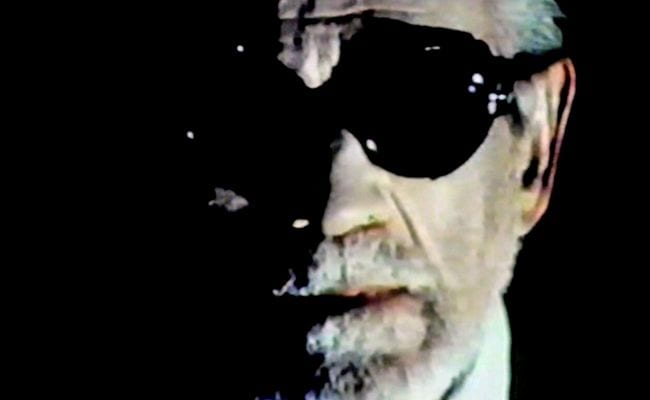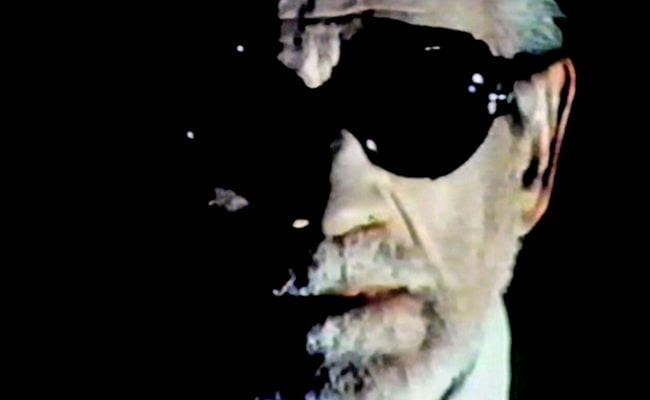
“Aren’t you overdoing the local color bit?” asks a pretty woman of the French reporter as he poses a mute housekeeper in picturesque Spanish peasant garb before a log on the beach. The answer is “yes”, but you work with what you’ve got, and this American-Spanish co-production had four things to its credit.
1. The natural production value of Malaga, Spain, with a fabulous Moorish mansion to play the home of a famous artist.
2. Boris Karloff, cadaverous, white-haired and near death, Here he spends much of his footage sitting or lying down, but he remains invaluably himself as cantankerous blind sculptor Franz Badulescu, wearing dark glasses and clutching his walking stick. He’d been brought in as a second choice after Claude Rains died, but the film is lucky to have him. Shot in 1967, this was one of Karloff’s final efforts, unreleased until 1970 in Spain and 1971 in the U.S.
3. The younger and fitter Viveca Lindfors to do the melodramatic heavy lifting as Tania, the artist’s tyrannical and amoral wife (not daughter, as the home video box claims), who engages a young lover to knock off locals whose skeletons may be used for her husband’s commissions. She tells her hubby that the bodies are from a morgue in another town, and he thinks that’s all right, but he warns her that people don’t take kindly to body snatching — a fact he would certainly know from his many previous movies.
Lindfors was an intelligent, hard-jawed beauty who perhaps was too unusual and disturbing a presence to break into real stardom, but this only helps her rep as a cult actress. Here she throws herself into a grand, angular, brittle role of barely repressed rapaciousness. She’s alternately charming, bullying, and menacing, and always in high style. (Get a load of her psychedelic S&M nightmare.) This is a quietly kinky effusion from the tail end of Franco’s Spain, and one could read something into that. Lindfors later appeared in a more remarkable Spanish horror movie, A Bell from Hell.
4. Promotional consideration from Pan Am and Cessna, duly thanked in the credits. This means time is wasted on pointless flying sequences with our top-billed journalist hero (Jean-Pierre Aumont, phoning it in), who’s less a hero than an opportunist. While trying to broker some real estate deals with a local bar-owner (Milo Quesada), whom we know from the get-go is bad, our journalist makes time with a lovely local artist (Rosenda Monteros) and her even lovelier model (Dianik Zurakowska), on whom the sculptor’s wife also has predatory designs. Also in the mix are a local drunk (Ruben Rojo), the mute maid (Jacqui Speed), and a Gypsy queen (Mercedes Rojo).
There’s no cauldron of blood, although there’s a boiling vat for rendering flesh (not acid, as everyone seems to assume) in the dungeon-like cellar beneath the artist’s mansion, where the heroine is interestingly left to rescue herself. The original Spanish title means “The Collector of Cadavers”; the film has also circulated as Blind Man’s Bluff. This print bears the psychedelic English credits for Cauldron of Blood, which include listing director Santos Alcocer as “realizador” and then promptly labeling it “A film by Edward Mann” (the co-writer). The plot has a few interesting misdirections amidst its bizarre and ridiculous details, which include a case of death by harp.
This print is a little worn but the colors look good. The soundtrack is English with no Spanish or other options, and it’s hard to know if some of the clumsy edits and optical close-ups are the same across all incarnations. For example, there’s clearly some censored monkeying with the scene of the pretty model’s death, as she’s abruptly naked and dead. Also, do all versions have the loungy jazzy score credited to Ray Ellis? We’ll have to wait for some Ultimate Edition to find out.


![Call for Papers: All Things Reconsidered [MUSIC] May-August 2024](https://www.popmatters.com/wp-content/uploads/2024/04/all-things-reconsidered-call-music-may-2024-720x380.jpg)



